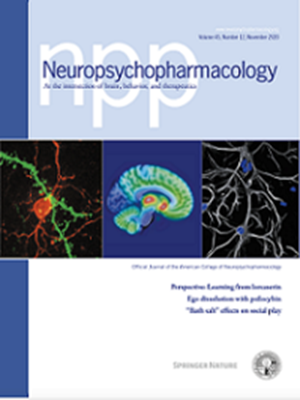Examining memory reconsolidation as a mechanism of nitrous oxide’s antidepressant action
IF 6.6
1区 医学
Q1 NEUROSCIENCES
引用次数: 0
Abstract
There is an ongoing need to identify novel pharmacological agents for the effective treatment of depression. One emerging candidate, which has demonstrated rapid-acting antidepressant effects in treatment-resistant groups, is nitrous oxide (N2O)—a gas commonly used for sedation and pain management in clinical settings and with a range of pharmacological effects, including antagonism of NMDA glutamate receptors. A growing body of evidence suggests that subanaesthetic doses of N2O (50%) can interfere with the reconsolidation of maladaptive memories in healthy participants and across a range of disorders. Negative biases in memory play a key role in the onset, maintenance, and recurrence of depressive episodes, and the disruption of affective memory reconsolidation is one plausible mechanism through which N2O exerts its therapeutic effects. Understanding N2O’s mechanisms of action may facilitate future treatment development in depression. In this narrative review, we introduce the evidence supporting an antidepressant profile of N2O and evaluate its clinical use compared to other treatments. With a focus on the specific memory processes that are thought to be disrupted in depression, we consider the effects of N2O on memory reconsolidation and propose a memory-based mechanism of N2O antidepressant action.研究记忆再巩固作为一氧化二氮抗抑郁作用的机制。
有一个持续的需要,以确定新的药物药物有效治疗抑郁症。一种新出现的候选药物,在治疗抵抗组中表现出快速的抗抑郁作用,是一氧化二氮(N2O)——一种在临床环境中通常用于镇静和疼痛管理的气体,具有一系列药理作用,包括NMDA谷氨酸受体的拮抗作用。越来越多的证据表明,亚麻醉剂量的N2O(50%)可以干扰健康参与者和一系列疾病患者适应不良记忆的重新巩固。记忆中的负偏倚在抑郁发作的发生、维持和复发中起着关键作用,而N2O对情感记忆再巩固的破坏是其发挥治疗作用的一种合理机制。了解N2O的作用机制可能有助于未来抑郁症治疗的发展。在这篇叙述性综述中,我们介绍了支持N2O抗抑郁作用的证据,并评估了其与其他治疗方法的临床应用。我们着眼于抑郁症中被认为中断的特定记忆过程,考虑了N2O对记忆再巩固的影响,并提出了N2O抗抑郁作用的基于记忆的机制。
本文章由计算机程序翻译,如有差异,请以英文原文为准。
求助全文
约1分钟内获得全文
求助全文
来源期刊

Neuropsychopharmacology
医学-精神病学
CiteScore
15.00
自引率
2.60%
发文量
240
审稿时长
2 months
期刊介绍:
Neuropsychopharmacology is a reputable international scientific journal that serves as the official publication of the American College of Neuropsychopharmacology (ACNP). The journal's primary focus is on research that enhances our knowledge of the brain and behavior, with a particular emphasis on the molecular, cellular, physiological, and psychological aspects of substances that affect the central nervous system (CNS). It also aims to identify new molecular targets for the development of future drugs.
The journal prioritizes original research reports, but it also welcomes mini-reviews and perspectives, which are often solicited by the editorial office. These types of articles provide valuable insights and syntheses of current research trends and future directions in the field of neuroscience and pharmacology.
 求助内容:
求助内容: 应助结果提醒方式:
应助结果提醒方式:


